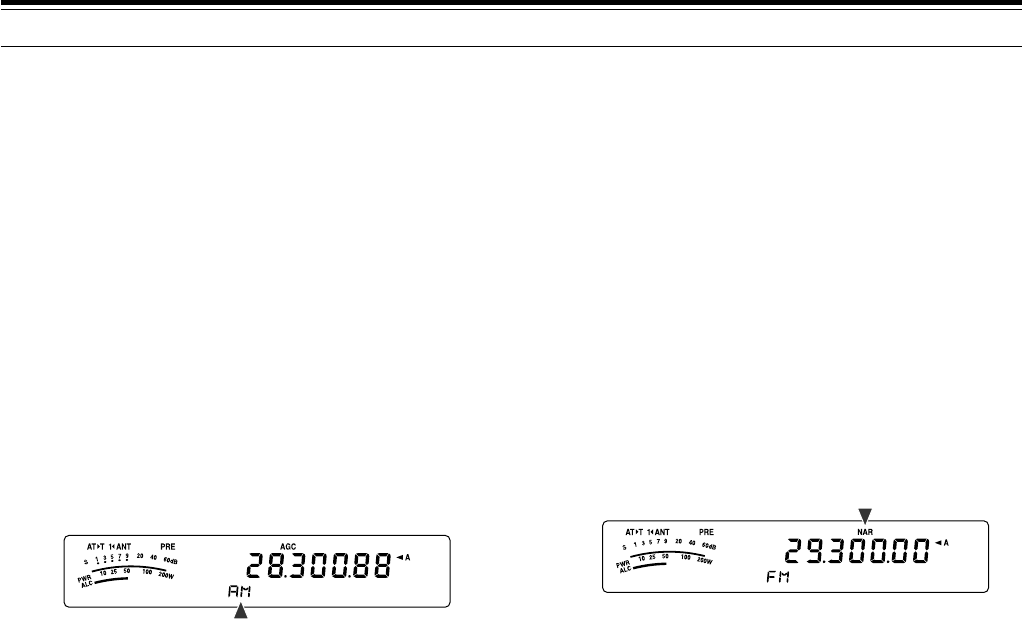
6 BASIC COMMUNICATIONS
28
AM TRANSMISSION
Each mode used on the HF Amateur bands has its
own advantages. Although long distance DX
contacts may be less common while using AM, the
superior audio quality characteristic of AM operation
is one reason why some hams prefer this mode.
When looking for others operating on AM, check the
following frequencies first:
3885 kHz, 7290 kHz, 14286 kHz, 21390 kHz, and
29000 ~ 29200 kHz
If necessary, refer to “OPERATING BASICS”,
beginning on page 18, for details on how to receive.
1 Select an operating frequency.
2 Press [MODE] until “AM” appears.
• If “AM” does not appear, select “FM” first, then
press [MODE] (1 s). The mode indicator
changes to “AM”.
3 Press [MIC/ 5/ RF.G] to enter the Microphone gain
adjutment mode.
• The current gain level appears on the sub-
display.
4 Press and hold Mic [PTT].
• The LED lights red.
• Refer to VOX function for information on
automatic TX/ RX switching {page 36}.
5 Speak into the microphone and adjust the
MULTI control so that the power meter slightly
reflects your voice level.
• Speak in your normal tone and level of voice.
Speaking too close to the microphone or too
loudly may increase distortion and reduce
intelligibility at the receiving end.
•You may want to use the Speech Processor.
Refer to “SPEECH PROCESSOR” {page 37}
for details.
6 Release Mic [PTT] to return to Reception mode.
• The LED lights green or turns off, depending
on the SQL control position.
7 Press [MIC/ 5/ RF.G] to exit the Microphone gain
adjustment mode.
Refer to “COMMUNICATING AIDS”, beginning on
page 34, for information on additional useful
operation functions.
Note:
When the TX power meter reading exceeds the value that you
specified in TX Power setting {page 65}, decrease the microphone
gain or adjust your tone and level of voice.
NARROW BANDWIDTH FOR FM
Select wide band or narrow band TX deviation
depending on whether the other station is using wide
band or narrow band filter for FM mode. While “NAR”
appears, the TS-480 transceiver transmits signals in
narrow band FM but the reception IF filter bandwidth
remains unchanged (Wide). The deviation selection
is crucial to avoid audio distortion or insufficient
intelligibility that the other station will encounter.
1 Press [MODE] until “FM” appears.
• If “FM” does not appear, select “AM” first, then
press [MODE] (1 s). The mode indicator
changes to “FM”.
2 Press [FIL/ NAR] (1 s) to toggle the selection
between wide and narrow TX deviation.
• “NAR” appears when the narrow TX deviation
is selected.
NARROW BANDWIDTH FOR AM
When receiving AM, you can further decrease the
bandwidth to eliminate interference. However, the
transmission deviation of AM is not affected by this
selection.
1 Press [MODE] until “AM” appears.
• If “AM” does not appear, select “FM” first, then
press [MODE] (1 s). The mode indicator
changes to “AM”.
2 Press [FIL/ NAR] (1 s) to toggle the selection
between Normal and Narrow.
• “NAR” appears when the narrow bandwidth is
selected for the AM reception.


















